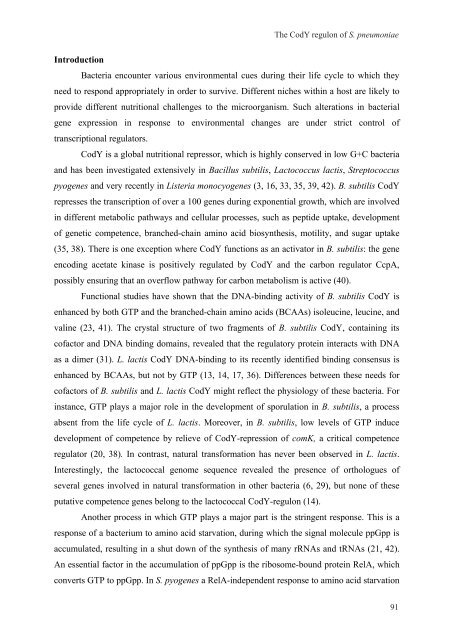Gene regulation in Streptococcus pneumoniae - RePub - Erasmus ...
Gene regulation in Streptococcus pneumoniae - RePub - Erasmus ...
Gene regulation in Streptococcus pneumoniae - RePub - Erasmus ...
You also want an ePaper? Increase the reach of your titles
YUMPU automatically turns print PDFs into web optimized ePapers that Google loves.
Introduction<br />
Bacteria encounter various environmental cues dur<strong>in</strong>g their life cycle to which they<br />
need to respond appropriately <strong>in</strong> order to survive. Different niches with<strong>in</strong> a host are likely to<br />
provide different nutritional challenges to the microorganism. Such alterations <strong>in</strong> bacterial<br />
gene expression <strong>in</strong> response to environmental changes are under strict control of<br />
transcriptional regulators.<br />
CodY is a global nutritional repressor, which is highly conserved <strong>in</strong> low G+C bacteria<br />
and has been <strong>in</strong>vestigated extensively <strong>in</strong> Bacillus subtilis, Lactococcus lactis, <strong>Streptococcus</strong><br />
pyogenes and very recently <strong>in</strong> Listeria monocyogenes (3, 16, 33, 35, 39, 42). B. subtilis CodY<br />
represses the transcription of over a 100 genes dur<strong>in</strong>g exponential growth, which are <strong>in</strong>volved<br />
<strong>in</strong> different metabolic pathways and cellular processes, such as peptide uptake, development<br />
of genetic competence, branched-cha<strong>in</strong> am<strong>in</strong>o acid biosynthesis, motility, and sugar uptake<br />
(35, 38). There is one exception where CodY functions as an activator <strong>in</strong> B. subtilis: the gene<br />
encod<strong>in</strong>g acetate k<strong>in</strong>ase is positively regulated by CodY and the carbon regulator CcpA,<br />
possibly ensur<strong>in</strong>g that an overflow pathway for carbon metabolism is active (40).<br />
Functional studies have shown that the DNA-b<strong>in</strong>d<strong>in</strong>g activity of B. subtilis CodY is<br />
enhanced by both GTP and the branched-cha<strong>in</strong> am<strong>in</strong>o acids (BCAAs) isoleuc<strong>in</strong>e, leuc<strong>in</strong>e, and<br />
val<strong>in</strong>e (23, 41). The crystal structure of two fragments of B. subtilis CodY, conta<strong>in</strong><strong>in</strong>g its<br />
cofactor and DNA b<strong>in</strong>d<strong>in</strong>g doma<strong>in</strong>s, revealed that the regulatory prote<strong>in</strong> <strong>in</strong>teracts with DNA<br />
as a dimer (31). L. lactis CodY DNA-b<strong>in</strong>d<strong>in</strong>g to its recently identified b<strong>in</strong>d<strong>in</strong>g consensus is<br />
enhanced by BCAAs, but not by GTP (13, 14, 17, 36). Differences between these needs for<br />
cofactors of B. subtilis and L. lactis CodY might reflect the physiology of these bacteria. For<br />
<strong>in</strong>stance, GTP plays a major role <strong>in</strong> the development of sporulation <strong>in</strong> B. subtilis, a process<br />
absent from the life cycle of L. lactis. Moreover, <strong>in</strong> B. subtilis, low levels of GTP <strong>in</strong>duce<br />
development of competence by relieve of CodY-repression of comK, a critical competence<br />
regulator (20, 38). In contrast, natural transformation has never been observed <strong>in</strong> L. lactis.<br />
Interest<strong>in</strong>gly, the lactococcal genome sequence revealed the presence of orthologues of<br />
several genes <strong>in</strong>volved <strong>in</strong> natural transformation <strong>in</strong> other bacteria (6, 29), but none of these<br />
putative competence genes belong to the lactococcal CodY-regulon (14).<br />
The CodY regulon of S. <strong>pneumoniae</strong><br />
Another process <strong>in</strong> which GTP plays a major part is the str<strong>in</strong>gent response. This is a<br />
response of a bacterium to am<strong>in</strong>o acid starvation, dur<strong>in</strong>g which the signal molecule ppGpp is<br />
accumulated, result<strong>in</strong>g <strong>in</strong> a shut down of the synthesis of many rRNAs and tRNAs (21, 42).<br />
An essential factor <strong>in</strong> the accumulation of ppGpp is the ribosome-bound prote<strong>in</strong> RelA, which<br />
converts GTP to ppGpp. In S. pyogenes a RelA-<strong>in</strong>dependent response to am<strong>in</strong>o acid starvation<br />
91<br />
91

















